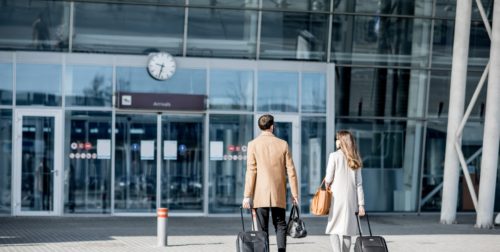In recent decades, air travel has dramatically boosted tourism. Airports, which are central to the aviation industry, have played a significant role in this. They’re more than just transit points; they now actively promote international tourism.
Airports have not only expanded travel options but have also been instrumental in developing tourist services, shaping our travel experiences. They serve as vital drivers that bring tourism to life. Join us as we explore role of airports in tourism and connecting the world.
Gateway to Adventure: The Role of Airports in Tourism
Airports have transformed from just transit spots into an essential part of the tourist industry. They’re central to marketing destinations, understanding that concrete and runways alone won’t attract travellers and airlines.
In this competitive field, airports not only serve tourists but also work to draw them in. They focus on marketing, not only within the terminal but also to airlines. They showcase a destination’s unique attractions, helping airlines see the potential for profitable routes. Passengers are also important, as airports aim to leave a good impression and spark their curiosity.
Additionally, airports play a vital role in improving the accessibility of tourist areas, acting as a crucial connection that swiftly and conveniently makes otherwise remote places accessible. Air travel often considered a budget-friendly way to explore the world, has greatly increased the convenience of reaching popular tourist destinations. This accessibility, coupled with the cost-saving advantages, serves as a magnet for tourists, promoting exploration and tourism.
From Check-In to Take-off: How Airports Affect Tourist Experience
Airports are crucial in shaping the tourist experience from arrival to departure. Their efficiency, design, services, and ambience significantly affect how tourists perceive a destination. The first impression at an airport sets the tone for the adventure ahead, and a clean, well-managed airport can create a positive initial experience.
Efficient check-in processes are therefore essential for a stress-free start, while security and immigration procedures, although necessary, can be a source of anxiety if characterized by long wait times and unfriendly staff.
Airport design and ambience can influence travellers’ moods, with modern, spacious, and visually pleasing airports contributing to a more positive atmosphere. Airports offering shopping, dining, lounges, and entertainment amenities enhance the tourist experience, especially during layovers or delays. Clear signage, multilingual information, and helpful staff on the other hand ease navigation and reduce stress.
Efficient connections from the airport to the final destination are also crucial in shaping the tourist’s experience. Well-connected airports with reliable public transportation links to the city centre make exploring the destination easier. The availability of rental cars, taxis, and rideshare services further enhances travellers’ ability to navigate and enjoy their trip.
Moreover, airports serve as cultural ambassadors by showcasing local cultures through art, music, and displays. This gives tourists a glimpse of what to expect in the region, igniting excitement and curiosity about their upcoming trip.
Airports as Tourist Destinations: Shopping, Dining, and More
These dynamic spaces now feature various amenities, expanding their appeal beyond just facilitating air travel. They have evolved into hubs offering excellent dining, shopping, and entertainment choices, enabling travellers to unwind and have a good time before departure, upon arrival, or during layovers.
Airport shopping now offers a wide range of retail options, from luxury boutiques to duty-free stores. Duty-free shopping is especially attractive due to its substantial savings on products like alcohol, cosmetics, and electronics. Moreover, high-end fashion boutiques and souvenir shops offer unique items, often specific to the region, for tourists to explore.
In addition to shopping, airports now provide various dining options to meet the needs of a diverse passenger population. This encompasses both regional and global cuisines. Many airports have fast food options for those in a rush before or after a flight, but some also have high-end places with Michelin stars or fine food for those who want a truly exceptional dining experience.
To make the tourist experience even better, airports provide numerous entertainment options and services. Lounges, provided by airlines and third-party services, offer relaxation, workspaces, and complimentary refreshments. Some airports have spas, yoga rooms, and fitness centres for those seeking relaxation. Cultural displays, art exhibitions, and concerts provide insights into local arts and entertainment.
Boosting Local Economies: How Tourism Benefits from Airport Development
Airport development benefits tourism in several ways. Firstly, it improves accessibility by creating new routes and connections, attracting more tourists and supporting the local tourism industry. It also enhances the first impression for arriving tourists.
Moreover, airport development promotes airline competition, resulting in more affordable airfares, increasing demand, and encouraging more tourists to visit. Airports often become hubs for various transportation options, making travel more convenient.
Economically, airport development creates jobs in construction, operation, and the broader tourism sector, stimulating local economies and infrastructure growth, benefiting hotels, restaurants, and cultural attractions.
Airline Partnerships: How Airports Collaborate to Improve Tourist Access
Collaborative efforts between airports and airlines are a cornerstone of enhancing tourist access. Their collaborative endeavours encompass diverse strategies designed to render travel more convenient, cost-effective, and enjoyable for tourists.
First and foremost, these partners collaborate closely to establish new flight routes and increase the frequency of existing ones, effectively improving connectivity to favoured tourist destinations. Airports often sweeten the deal for airlines with incentives like reduced landing fees and marketing support, ultimately benefiting tourists.
Codeshare agreements represent another pivotal facet of this partnership, allowing airlines to combine their flights and routes. This expands destination options and streamlines connections for tourists. For instance, tourists departing from smaller regional airports can access international locations through major hub airports thanks to codeshare agreements between regional and major airlines.
Joint marketing ventures are also a standard feature of airport and airline cooperation. These encompass advertising campaigns, online promotions, and travel packages, all designed to simplify the planning and booking process for tourists. Through this joint effort, airports and airlines effectively market their regions and attract more visitors.
Airlines further collaborate with local businesses and tourism boards to enrich the in-flight experience. This involves showcasing local cuisine, providing travel guides, and promoting nearby tourist attractions, offering tourists a taste of the destination before they even arrive, enhancing their overall experience.



